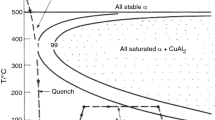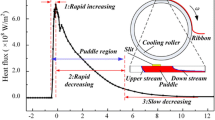Abstract
Solution heat treatment combined with a rapid quenching operation, which can effectively suppress the decomposition of the supersaturated solid solution in the matrix, is a vital process step for producing large precipitation-hardenable aluminum alloy thick plates with desired properties. However, large thermal gradients that result from the non-uniform cooling rates during quenching usually give rise to severely heterogeneous distributions of residual stress in thick plates. The presence of roller-hearth furnaces makes it possible to achieve continuous and integral solution-quenching treatment for large aluminum alloy thick plates. The conveyor velocity of the roller table in the roller-hearth furnace is a key parameter but its influence is less addressed in literature. Thus, in the present work, finite element thermal-mechanical simulations taking into account different conveyor velocities of the roller table were employed to predict the temperature variations and residual stress distributions in large aluminum alloy thick plates during quenching process. Four different velocities were utilized in the simulations. The modeling results showed that the temperature evolutions as well as the distributions of the induced internal stresses in those large thick plates during quenching treatments were indeed affected by the conveyor velocities. Slower velocities were demonstrated to be favorable for gaining thick plates being with relatively homogeneous residual stress distributions in the plates.
摘要
固溶-淬火热处理可有效抑制合金基体中过饱和固溶体的分解,是生产具有理想性能的大规格沉淀强化型铝合金厚板的重要工艺步骤。然而厚板淬火过程中,因冷却速度不均匀而产生的巨大温度梯度通常会导致厚板中内部形成严重不均匀分布的残余应力。辊底式淬火炉的出现确保了大规格铝合金厚板连续、整体的固溶-淬火处理。大规格铝合金厚板固溶-淬火处理过程中,淬火炉内部辊道的传送速度是影响厚板内部残余应力分布的一个关键工艺参数,但其在以往的文献中较少涉及。因此,本研究通过考虑辊道的传送速度并采用热力耦合有限元模拟的方法开展了大规格铝合金厚板淬火过程中的温度变化和残余应力分布预测。模拟过程中选用了四种不同的辊道传送速度。结果表明,大规格铝合金厚板淬火处理过程中内部温度演变及其所诱发的残余应力分布受辊道传送速度的影响。较慢的辊道传送速度有助于获得残余应力分布相对均匀的大规格厚板。
Similar content being viewed by others
References
STARKE JR E A, STALEY J T. Application of modern aluminum alloys to aircraft [J]. Progress in Aerospace Sciences, 1996, 32(2): 131–172.
IMMARIGEON J P, HOLT R T, KOUL A K, et al. Lightweight materials for aircraft applications [J]. Materials Characterization, 1995, 35(1): 41–67.
DURSUN T, SOUTIS C. Recent developments in advanced aircraft aluminium alloys [J]. Materials & Design (1980–2015), 2014, 56: 862–871.
MOLDENHAUER S, VAN DER LUGT J, HOOG-LAND H, et al. Recent improvement in high strength thick AA7050-plate [J]. Materials Science Forum, 2000, 331/332/333/334/335/336/337: 1101–1106.
CHOBAUT N, CARRON D, ARSÈNE S, et al. Quench induced residual stress prediction in heat treatable 7xxx aluminium alloy thick plates using Gleeble interrupted quench tests [J]. Journal of Materials Processing Technology, 2015, 222: 373–380.
TANNER D A, ROBINSON J S. Residual stress prediction and determination in 7010 aluminum alloy forgings [J]. Experimental Mechanics, 2000, 40(1): 75–82.
ROBINSON J S, REDINGTON W. The influence of alloy composition on residual stresses in heat treated aluminium alloys [J]. Materials Characterization, 2015, 105: 47–55.
KOÇ M, CULP J, ALTAN T. Prediction of residual stresses in quenched aluminum blocks and their reduction through cold working processes [J]. Journal of Materials Processing Technology, 2006, 174(1/2/3): 342–354.
DOLAN G P, ROBINSON J S. Residual stress reduction in 7175-T73, 6061-T6 and 2017A-T4 aluminium alloys using quench factor analysis [J]. Journal of Materials Processing Technology, 2004, 153/154: 346–351.
RASOULI YAZDI S, RETRAINT D, LU J. Study of through-thickness residual stress by numerical and experimental techniques [J]. The Journal of Strain Analysis for Engineering Design, 1998, 33(6): 449–458.
FERNANDES F A P, CHRISTIANSEN T L, WINTHER G, et al. On the determination of stress profiles in expanded austenite by grazing incidence X-ray diffraction and successive layer removal [J]. Acta Materialia, 2015, 94: 271–280.
MAHMOODI M, SEDIGHI M, TANNER D A. Investigation of through thickness residual stress distribution in equal channel angular rolled Al 5083 alloy by layer removal technique and X-ray diffraction [J]. Materials & Design, 2012, 40: 516–520.
CHOBAUT N, REPPER J, PIRLING T, et al. Residual stress analysis in AA7449 as-quenched thick plates using neutrons and Fe modelling [C]//Proceedings of the 13th International Conference on Aluminum Alloys (ICAA13). Cham: Springer, 2012: 285–291.
JEANMART P, BOUVAIST J. Finite element calculation and measurement of thermal stresses in quenched plates of high-strength 7075 aluminium alloy [J]. Materials Science and Technology, 1985, 1(10): 765–769.
LI H Y, ZHANG Y D, ZHANG H W. Finite element analysis for comprehensive residual stress of 7075 aluminum alloy thick plate [J]. Advanced Materials Research, 2010, 154/155: 1255–1261.
GONG H, WU Y X, YANG Z P, et al. Analysis of quenching and stretching processes of aluminum alloy thick plates [J]. Advanced Materials Research, 2014, 996: 532–537.
LI Y N, ZHANG Y A, LI X W, et al. Quenching residual stress distributions in aluminum alloy plates with different dimensions [J]. Rare Metals, 2019, 38(11): 1051–1061.
DONG H Y, KE Y L, SUN J, et al. Finite element method simulation for residual stress in quenched aluminum alloy thick-plate and its effect on machining distortion [J]. Acta Aeronautica et Astronautica Sinica, 2004, 25(4): 429–432. (in Chinese).
ŞIMŞIR C, GÜR C H. A FEM based framework for simulation of thermal treatments: Application to steel quenching [J]. Computational Materials Science, 2008, 44(2): 588–600.
CAO H L, LI X W, LI Y N, et al. Numerical simulation of quenching and pre-stretching residual stress in 7085 aluminum alloy plate [J]. Materials Science Forum, 2016, 852: 211–217.
CAO H L. Measurement and numerical simulation of quenching residual stress in 7055 aluminum alloy thick plate [D]. Beijing: General Research Institute for Non-ferrous Metals, 2016. (in Chinese).
HALL D D, MUDAWAR I. Optimization of quench history of aluminum parts for superior mechanical properties [J]. International Journal of Heat and Mass Transfer, 1996, 39(1): 81–95.
ROBINSON J S, TANNER D A. The influence of aluminium alloy quench sensitivity on the magnitude of heat treatment induced residual stress [J]. Materials Science Forum, 2006, 524/525: 305–310.
LI Y N. Study on evolution and prediction of quenching and pre-stretching residual stress of 7055 aluminum alloy thick plate [D]. Beijing: General Research Institute for Nonferrous Metals, 2017. (in Chinese).
Author information
Authors and Affiliations
Corresponding author
Additional information
Foundation item
the National Program on Key Research and Development Project of China (No. 2020YFF0218202), and the Innovation Fund Project of GRINM Group Co., Ltd.
Rights and permissions
About this article
Cite this article
Zhu, K., Xiong, B., Yan, H. et al. Numerical Simulation on the Effect of Conveyor Velocity of the Roller Table on Stress Distribution and Evolution in Large Aluminum Alloy Thick Plates. J. Shanghai Jiaotong Univ. (Sci.) 28, 255–263 (2023). https://doi.org/10.1007/s12204-021-2389-y
Received:
Accepted:
Published:
Issue Date:
DOI: https://doi.org/10.1007/s12204-021-2389-y
Key words
- conveyor velocity
- roller table
- residual stress
- finite element
- thermal-mechanical simulation
- aluminum alloy
- thick plate




